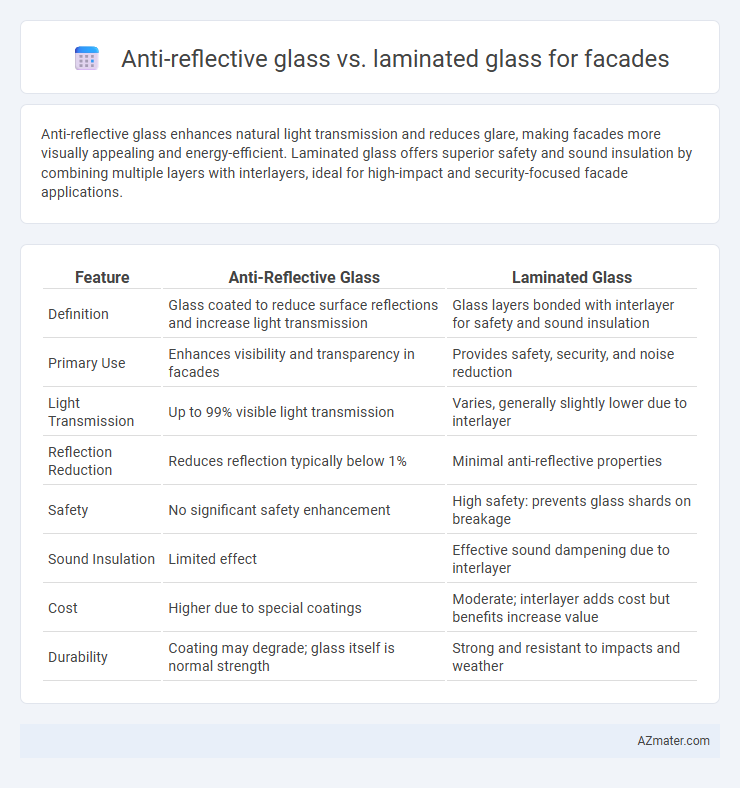Anti-reflective glass enhances natural light transmission and reduces glare, making facades more visually appealing and energy-efficient. Laminated glass offers superior safety and sound insulation by combining multiple layers with interlayers, ideal for high-impact and security-focused facade applications.
Table of Comparison
| Feature | Anti-Reflective Glass | Laminated Glass |
|---|---|---|
| Definition | Glass coated to reduce surface reflections and increase light transmission | Glass layers bonded with interlayer for safety and sound insulation |
| Primary Use | Enhances visibility and transparency in facades | Provides safety, security, and noise reduction |
| Light Transmission | Up to 99% visible light transmission | Varies, generally slightly lower due to interlayer |
| Reflection Reduction | Reduces reflection typically below 1% | Minimal anti-reflective properties |
| Safety | No significant safety enhancement | High safety: prevents glass shards on breakage |
| Sound Insulation | Limited effect | Effective sound dampening due to interlayer |
| Cost | Higher due to special coatings | Moderate; interlayer adds cost but benefits increase value |
| Durability | Coating may degrade; glass itself is normal strength | Strong and resistant to impacts and weather |
Introduction to Facade Glazing Solutions
Facade glazing solutions enhance building aesthetics and energy efficiency by integrating advanced glass technologies. Anti-reflective glass reduces glare and improves transparency, maximizing natural light transmission while maintaining clear views. Laminated glass offers superior safety and sound insulation by combining multiple glass layers with interlayers, making it ideal for facade applications requiring durability and security.
What is Anti-Reflective Glass?
Anti-reflective glass is specially coated to reduce glare and reflections, enhancing transparency and visual clarity in building facades. This technology improves natural light transmission while minimizing the mirror-like effects often seen on standard glass surfaces. It is ideal for modern architectural applications where aesthetics and energy efficiency are critical.
What is Laminated Glass?
Laminated glass consists of two or more glass layers bonded together with an interlayer, typically made of polyvinyl butyral (PVB), offering enhanced safety and security for facades by preventing shattering upon impact. Anti-reflective glass reduces glare and reflections through specialized coatings, improving visual clarity and energy efficiency but does not provide the same structural benefits as laminated glass. In facade applications, laminated glass is preferred for its durability, sound insulation, and protection against breakage, while anti-reflective glass optimizes aesthetic appeal and daylight transmission.
Key Functional Differences
Anti-reflective glass for facades significantly reduces surface glare and enhances natural light transmission, improving visibility and aesthetic appeal. Laminated glass offers superior safety and security by holding shattered fragments together, providing impact resistance and enhanced sound insulation. While anti-reflective glass optimizes optical performance, laminated glass prioritizes structural integrity and occupant protection in facade applications.
Light Transmission and Visual Clarity
Anti-reflective glass offers superior light transmission rates of up to 98%, significantly reducing glare and enhancing visual clarity in facade applications. Laminated glass, while providing safety and sound insulation with its interlayer, typically exhibits slightly lower light transmission, around 85-90%, due to the bonding film. Choosing between these glass types depends on the primary needs of maximum daylight penetration and clear views versus safety and acoustic performance.
Safety and Security Performance
Anti-reflective glass enhances visibility by reducing glare and reflections, improving facade aesthetics and occupant comfort but offers limited resistance to impact or forced entry. Laminated glass consists of multiple layers bonded with an interlayer, providing superior safety by preventing glass shattering and enhanced security through resistance to penetration and vandalism. For facades requiring robust protection, laminated glass delivers better safety and security performance compared to anti-reflective glass.
Energy Efficiency and Thermal Comfort
Anti-reflective glass enhances energy efficiency by maximizing natural daylight penetration while reducing glare, which lowers reliance on artificial lighting and improves occupant comfort. Laminated glass improves thermal comfort through its multi-layer structure that provides superior insulation and reduces heat transfer, resulting in better temperature regulation within the building. Combining anti-reflective coatings with laminated glass technology can optimize facade performance by balancing light transmission and thermal insulation, leading to significant energy savings and enhanced indoor environmental quality.
Durability and Maintenance Needs
Anti-reflective glass offers enhanced durability with a hard coating that reduces glare and resists scratches, minimizing the need for frequent cleaning and maintenance in facade applications. Laminated glass provides superior safety and impact resistance by combining multiple glass layers with interlayers, but may require periodic inspection for interlayer integrity and potential edge degradation. Both types demand routine cleaning; however, anti-reflective glass typically experiences lower maintenance costs due to its protective surface treatments.
Aesthetic Considerations for Building Design
Anti-reflective glass enhances facade aesthetics by minimizing glare and reflections, ensuring a clear, uninterrupted view of the building's interior and exterior elements. Laminated glass offers a sleek, smooth surface with the added benefit of design versatility through embedded interlayers, allowing for customized colors and textures that enhance visual appeal. Both options contribute to modern architectural elegance, but anti-reflective glass excels in clarity while laminated glass emphasizes design flexibility and safety.
Choosing the Right Glass for Your Facade
Selecting the right glass for your facade depends on balancing aesthetics, safety, and performance; anti-reflective glass enhances visibility by minimizing glare and improving light transmission, making it ideal for modern commercial buildings seeking a sleek, clear appearance. Laminated glass provides superior safety and security by holding together when shattered, ideal for facades requiring impact resistance and enhanced durability against weather or vandalism. Evaluating factors such as energy efficiency, maintenance, and local building codes helps determine whether anti-reflective or laminated glass best suits your facade's functional and design requirements.

Infographic: Anti-reflective glass vs Laminated glass for Facade
 azmater.com
azmater.com